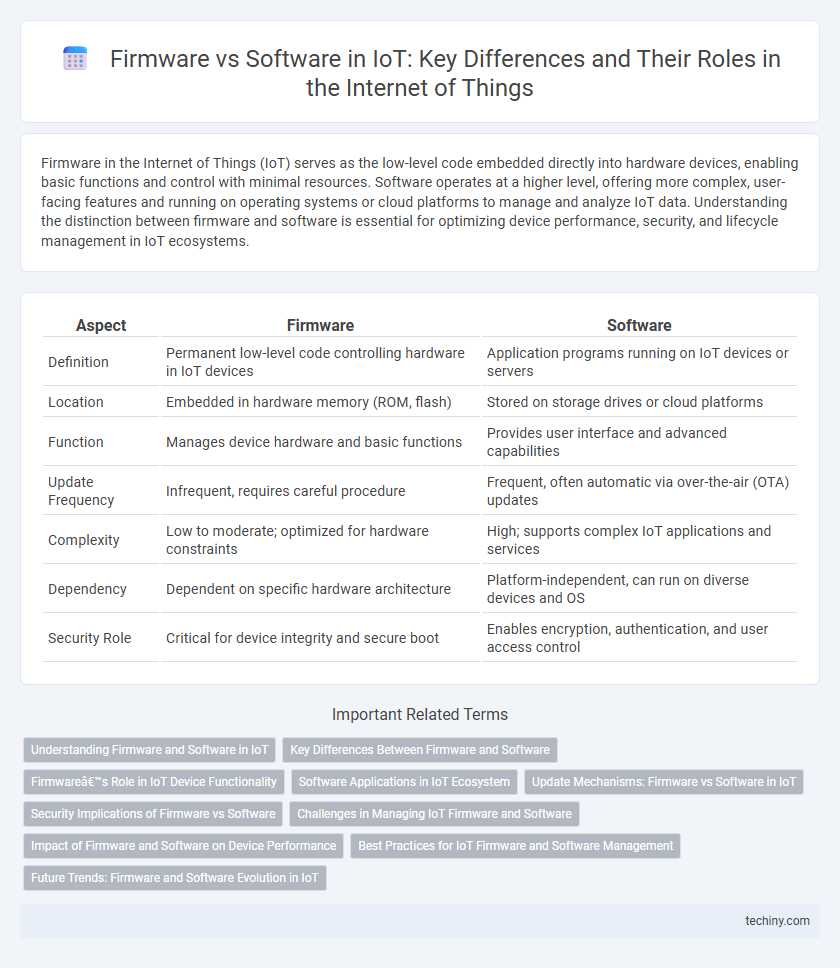Firmware in the Internet of Things (IoT) serves as the low-level code embedded directly into hardware devices, enabling basic functions and control with minimal resources. Software operates at a higher level, offering more complex, user-facing features and running on operating systems or cloud platforms to manage and analyze IoT data. Understanding the distinction between firmware and software is essential for optimizing device performance, security, and lifecycle management in IoT ecosystems.
Table of Comparison
| Aspect | Firmware | Software |
|---|---|---|
| Definition | Permanent low-level code controlling hardware in IoT devices | Application programs running on IoT devices or servers |
| Location | Embedded in hardware memory (ROM, flash) | Stored on storage drives or cloud platforms |
| Function | Manages device hardware and basic functions | Provides user interface and advanced capabilities |
| Update Frequency | Infrequent, requires careful procedure | Frequent, often automatic via over-the-air (OTA) updates |
| Complexity | Low to moderate; optimized for hardware constraints | High; supports complex IoT applications and services |
| Dependency | Dependent on specific hardware architecture | Platform-independent, can run on diverse devices and OS |
| Security Role | Critical for device integrity and secure boot | Enables encryption, authentication, and user access control |
Understanding Firmware and Software in IoT
Firmware in IoT refers to the low-level, embedded code that directly controls hardware functions, enabling devices like sensors and actuators to operate efficiently. Software in IoT encompasses higher-level applications and platforms that manage data processing, user interfaces, and network communications across connected devices. Distinguishing firmware from software is crucial for optimizing device performance, security, and update strategies in IoT ecosystems.
Key Differences Between Firmware and Software
Firmware is embedded code stored in non-volatile memory that directly controls hardware functions in IoT devices, providing low-level control essential for basic operations. Software refers to higher-level programs running on an operating system, enabling complex functionalities and user interactions in IoT ecosystems. Firmware updates are less frequent and critical for device stability, while software updates occur more regularly to enhance features and security.
Firmware’s Role in IoT Device Functionality
Firmware acts as the critical bridge between IoT hardware and software applications, enabling seamless device operation and control. It provides low-level instructions that directly manage sensors, actuators, and communication modules, ensuring reliable performance and security. Regular firmware updates optimize device functionality, enhance security protocols, and support interoperability in complex IoT ecosystems.
Software Applications in IoT Ecosystem
Software applications in the Internet of Things ecosystem enable seamless device communication, data analytics, and real-time decision-making, driving intelligent automation across industries. These applications run on various platforms such as cloud services, edge devices, and mobile interfaces, facilitating interoperability and scalability. Advanced IoT software integrates machine learning algorithms and security protocols to enhance performance and safeguard connected devices from cyber threats.
Update Mechanisms: Firmware vs Software in IoT
Firmware update mechanisms in IoT devices typically require direct hardware access and are often performed via specialized protocols like OTA (Over-The-Air) updates to ensure device integrity and security. Software updates, in contrast, are managed at the application layer and can be deployed more frequently through standard internet connections using APIs or cloud services. Efficient and secure update mechanisms are crucial for maintaining IoT device functionality, patching vulnerabilities, and enhancing performance across diverse network environments.
Security Implications of Firmware vs Software
Firmware in Internet of Things (IoT) devices operates at a low-level, often embedded directly into hardware, making it a critical vector for security vulnerabilities due to its persistent presence and limited update mechanisms. Software, typically higher-level applications and operating systems, can be patched more frequently but still faces risks such as exploitation of code flaws or unauthorized access. Ensuring robust security in IoT requires stringent firmware validation, secure boot processes, and regular software updates to mitigate threats across both layers.
Challenges in Managing IoT Firmware and Software
Managing IoT firmware and software involves challenges such as ensuring secure and timely updates across diverse and often resource-constrained devices, which are prone to vulnerabilities. Compatibility issues arise due to the variety of hardware architectures and operating systems used in IoT ecosystems, complicating maintenance and scalability. Effective management requires robust version control, automated deployment mechanisms, and comprehensive monitoring to mitigate risks and enhance device reliability.
Impact of Firmware and Software on Device Performance
Firmware provides low-level control and optimized efficiency for IoT devices, enabling fast boot times and reliable hardware interactions critical for real-time data processing. Software offers flexibility and scalability, allowing updates and feature enhancements that improve user experience and device interoperability over time. Both firmware and software critically influence device performance by balancing stability, responsiveness, and adaptability in connected ecosystems.
Best Practices for IoT Firmware and Software Management
Effective IoT firmware and software management requires regular updates to enhance security and functionality while minimizing downtime. Implementing over-the-air (OTA) update mechanisms ensures seamless deployment across diverse device ecosystems and helps maintain consistent performance. Prioritizing robust version control and rollback capabilities allows quick recovery from faulty releases, safeguarding device integrity and user trust.
Future Trends: Firmware and Software Evolution in IoT
Firmware in IoT devices is evolving towards greater flexibility and over-the-air update capabilities, enabling enhanced security and functionality without physical intervention. Software advancements are driving smarter, AI-integrated IoT ecosystems that offer predictive analytics and seamless device interoperability. Future trends emphasize convergence where firmware and software collaboratively optimize device performance and energy efficiency in increasingly connected environments.
Firmware vs Software Infographic

 techiny.com
techiny.com